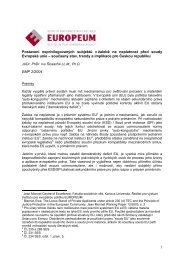eu constitutionalisation - EUROPEUM Institute for European Policy
eu constitutionalisation - EUROPEUM Institute for European Policy
eu constitutionalisation - EUROPEUM Institute for European Policy
Create successful ePaper yourself
Turn your PDF publications into a flip-book with our unique Google optimized e-Paper software.
Chapter 5: The <strong>European</strong> Constitution and the Re<strong>for</strong>m of External Competencesinternal treaty provision.²⁹ To assume that the legislator would be entirelyfree to donate such powers in laws or framework laws, which may eventuallybe adopted by qualified majority voting, would provide it to some extentwith the competence to confer competences which would contradict thefundamental principles of competence allocation. Stefan Griller there<strong>for</strong>esuggests that it would seem appropriate to only admit the conferral of suchcompetences through an act of secondary law, if the conclusion of an internationalagreement at least facilitates the attainment of an internal Unionobjective.³⁰ This would, in fact, correspond to the conditions established <strong>for</strong>concurrent implied competences, as elaborated by Griller and Gamharter.³¹Even pursuant to this understanding, however, it is submitted that thisprovision, if used in practice by the legislator, may considerably extend theUnion’s external competences.Turning to Art. III-323 and the corresponding passage in this provision,it immediately stands out that the conditions differ in one remarkableaspect. External competence is stated to arise where the conclusion of anagreement is provided <strong>for</strong> “in a binding Union legal act”. This leads to thequestions of which acts may be addressed that are not already coveredby Art I-13 CT and which kind of external competence the CT therebyintends to confer. With a view to Art. I-33 CT on the legal acts of theUnion, it seems that the principal application might be the “<strong>European</strong>decisions” which are non-legislative acts, binding in their entirety. Oneprominent field of application where legislative acts are excluded andwhere the principally applicable instrument are <strong>European</strong> decisions is theCFSP. If the current wording of Art. III-323 CT remains, it would signifythat (implied) external competences might arise in the CFSP wherea <strong>European</strong> decision in this field so provides. This seems particularlyinteresting with a view to the extension of qualified majority voting inthis area. What remains unclear, however, is the type of competence thatArt. III-323 CT in conjunction with the respective “binding Union legalact” should confer, as exclusive external competences are limited to theconferral of powers through legislative acts (Art. I-13 CT). With a viewto the residual character of this category (Art. I-14 para 1 CT), one mightconsider that it leads to a shared competence and the constitutional treatythus finally resolves the questions of (implied) shared competences.29) GRILLER (2004), p. 41.30) Ibid.31) GRILLER and GAMHARTER (2002), p.79f.Chapter 5: The <strong>European</strong> Constitution and the Re<strong>for</strong>m of External CompetencesAdmittedly, however, it remains doubtful, whether this would indeedhave reflected the intention of the drafters.b. …or is necessary to enable the Union to exercise its internal competenceThe second element of Art. I-13 CT reflects Opinion 1/76, where the Courtstipulated that “whenever Community Law has created <strong>for</strong> the institutions ofthe Community powers within its internal system <strong>for</strong> the purpose of attaininga specific objective, the Community has authority to enter into the internationalcommitments necessary <strong>for</strong> the attainment of that objective even in the absenceof an express provision in that connexion.”³² The “inextricable link” requiredbetween the conclusion of the international agreement and the adoptionof internal measures <strong>for</strong> the attainment of a Community objective is<strong>for</strong>mulated pointedly in Art I-13 CT.³³In contrast, it is again the analogical provision in Art. III-323 CT thatgives rise to bewilderment. It confers competences, “where the conclusionof an agreement is necessary in order to achieve, within the frameworkof the Union’s policies, one of the objectives fixed by the Constitution”. Again,the reason remains nebulous as to why the terminology differs in sucha manner from Art. I-13 CT. There is no explanation in any of the draftingdocuments relating to these provisions. There<strong>for</strong>e, it is also difficult todetermine which concept of necessity is implied under this provision. Ifit were the concept of Opinion 1/76, why then was the terminology ofArt. I-13 CT not adopted? To argue that Art. III-323 CT only constituteda reflection and repetition of Art. I-13 CT, as it occurs several times in PartI and Part III of the draft, would call its wording entirely into question.Again, the second alternative might be to imply the concept of necessityin the light of shared (concurrent) implied competences. The “necessity”(which in the German version is translated as “er<strong>for</strong>derlich”) in Art. III-323 CT would then (merely) require that the international agreement,in the framework of internal policies, facilitates the achievement ofa Union objective. In the light of the significantly expanded objectives,particularly in the field of external relations, this would again extend thepotential scope <strong>for</strong> external powers to a considerable degree. Yet, withthe legal basis <strong>for</strong> implied competences in the first option of Art. I-13 CT32) Opinion 1/76 of 26 April 1977, ECR 1977/741, para 3.33) The fact that the Union has to exercise its competences in order to attain the objectives set out in theConstitution is anyway presumed by Art. I-11 para 2 CT.158159








